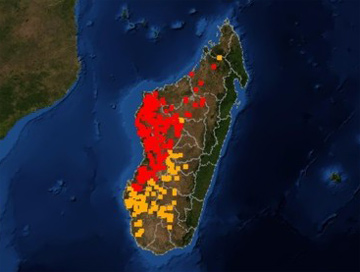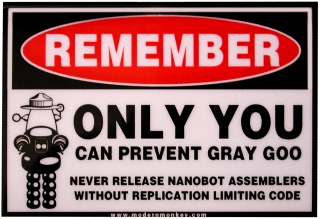| The Hormel Hunger Survey released on Monday also showed 53 percent of Americans polled believe government subsidies for ethanol production will help reduce US dependence on foreign oil, but nearly as many -- 47 percent -- oppose the subsidies because they increase food prices. Last week Jean Ziegler, the United Nations Special Rapporteur on the right to food, called for a five-year moratorium on biofuels, saying it was a "crime against humanity" to convert food crops to fuel at a time when there are more than 850 million hungry people in the world. Read more by Andrea Hopkins
Today, BP Products North America, Inc. agreed to pay a total criminal fine of more than $60 million for violations of federal environmental regulations in Texas and Alaska. In addition to the penalty, the company will spend approximately $400 million on safety upgrades and improvements to prevent future chemical releases and spills. "BP committed serious environmental crimes in our two largest states, with terrible consequences for people and the environment," said Granta Nakayama, assistant administrator for EPA's Office of Enforcement and Compliance Assurance. "Today's agreement sends a message that these types of crimes will be prosecuted." This is the largest criminal fine ever assessed against a corporation for Clean Air Act violations and the first criminal prosecution of the requirement that refineries and chemical plants take steps to prevent accidental releases. The requirement was passed in 1990 as part of the Clean Air Act following the explosion at the Union Carbide chemical plant in Bhopal, India where thousands were killed and injured. BP will pay $50 million for a catastrophic explosion in 2005 that killed 15 people and injured more than 170 others at its Texas City refinery. BP will also pay a $12 million fine for spilling 200,000 gallons of crude oil onto the Alaskan tundra and onto a frozen lake in March 2006, resulting in the largest spill that ever occurred on the North Slope. In addition to the $50 million fine, the company pleaded guilty to a felony violation of the Clean Air Act and will serve three years of probation for the Texas City incident. BP is also required to complete a facility-wide study of its safety valves and renovate its flare system to prevent excess emissions at an estimated cost of $265 million. Read more from http://www.chemalliance.org/news/index.asp?StoryID=2194
"After decades of inaction, the federal government is finally forcing states to clean up their polluted rivers, lakes and bays, but is providing virtually none of the funding to do so. Neither is the state of Florida, which has appropriated $10 million a year to deal with what state officials estimate will be a $10 billion cleanup. That means cities and counties, which are struggling with money problems of their own, will shoulder most of the financial burden. 'The bottom line is these problems are locally generated and are the results of increased development and increased pressure on water,' said Tom Singleton, whose job at the state Department of Environmental Protection is helping local governments develop cost-effective ways to reduce pollution. For many counties, the costs will be enormous. Pasco County officials estimate they will have to spend $260 million building systems to clean up nutrient pollution that washes into the upper Hillsborough River and tributaries." Mike Salinero reports for the The Tampa Tribune Oct. 25, 2007.
 The sweet notion that making a company environmentally friendly can be not just cost-effective but profitable is going up in smoke. Read this monumentally silly article at Business Week but also look at the very good slide show, with their take on who is going green and who is just a greenwashing poseur. The sweet notion that making a company environmentally friendly can be not just cost-effective but profitable is going up in smoke. Read this monumentally silly article at Business Week but also look at the very good slide show, with their take on who is going green and who is just a greenwashing poseur.
Auden Schendler learned about corporate environmentalism directly from the prophet of the movement. In the late 1990s, Schendler was working as a junior researcher at the Rocky Mountain Institute, a think tank in Aspen led by Amory Lovins, legendary author of the idea that by "going green," companies can increase profits while saving the planet. As Lovins often told Schendler and others at the institute, boosting energy efficiency and reducing harmful emissions constitute not just a free lunch but "a lunch you're paid to eat." Inspired by this marvelous promise, Schendler took a job in 1999 at Aspen Skiing Co., becoming one of the first of a new breed: the in-house "corporate sustainability" advocate. Eight years later, it takes him six hours crisscrossing the Aspen region by car and foot to show a visitor some of the ways he has helped the posh, 800-employee resort blunt its contribution to global warming. Schendler, 37, a tanned and muscular mountain climber, clambers atop a storage shed to point out sleek solar panels on an employee-housing rooftop. He hikes down a stony slope for a view of the resort's miniature power plant, fueled by the rushing waters of a mountain creek. The company features its environmental credentials in its marketing and has decorated its headquarters with green trophies and plaques. Last year Time honored Schendler as a "Climate Crusader" in an article accompanied by a half-page photo of the jut-jawed executive standing amid snow-covered evergreens.
But at the end of this arid late-summer afternoon, Schendler is feeling anything but triumphant. He pulls a company sedan to the side of a dirt road and turns off the motor. "Who are we kidding?" he says, finally. Despite all his exertions, the resort's greenhouse-gas emissions continue to creep up year after year. More vacationers mean larger lodgings burning more power. Warmer winters require tons of additional artificial snow, another energy drain. "I've succeeded in doing a lot of sexy projects yet utterly failed in what I set out to do," Schendler says. "How do you really green your company? It's almost f------ impossible." ...More interesting is the reaction to the article from one of the businesses cited in the article, Johnson and Johnson, as expressed on their corporate blog: But failed to mention : Johnson and Johnson has proclaimed a 17% reduction in carbon emissions since 1990, based largely on RECs. Without the credits, the pharmaceutical giant has seen a 24% increase.
That's true . . . apart from the fact that Johnson and Johnson is not merely a "pharmaceutical" company . . . but it also fails to tell the whole story.
At first blush, a 24 percent increase in carbon emissions since 1990 does sound significant. And contrasted with the company's claimed 17 percent reduction, it almost makes J and J sound dishonest or hypocritical.
Associated Press: The White House on Wednesday denied that it ``watered down'' congressional testimony that the director of the Centers for Disease Control and Prevention delivered on the impact climate change is having on public health. Two sources familiar with the documents said the White House severely edited the CDC director's congressional testimony, removing specific scientific references to potential health risks. Dr. Julie Gerberding, director of the Atlanta-based CDC, the ... Link
 The City of Ann Arbor, Michigan, the newest LED City™, expects to install more than 1,000 LED streetlights beginning next month. The City anticipates a 3.8-year payback on its initial investment. The LED lights typically burn five times longer than the bulbs they replace and require less than half the energy. The LED streetlights currently installed in Ann Arbor are based on the New Westminster Series made by Lumec, Inc., which contain LED light engines from Relume Technologies, Inc. The light engines are based on the performance-leading Cree XLamp® LED. Full implementation of LEDs is projected to cut Ann Arbor's public lighting energy use in half and reduce greenhouse gas emissions by 2,425 tons of CO2 annually, the equivalent of taking 400 cars off the road for a year. Detroit Edison, Ann Arbor's local utility provider, will meter the new LED streetlights with the intent to gather sufficient information to develop new LED-based tariffs. One of the reasons LED light clusters quickly became popular on traffic lights is because long-lasting LEDs reduce maintenance costs, increase public safety (no completely dead lights at rush hour) and avoid traffic blockages during maintenance. A similar rationale lies behind the increasing popularity of LED clusters in automotive lights. The advantages of LED street lights, similarly, are significant beyond mere payback on energy savings. Via::Cree & Treehugger
In June 2006, ABCnews.com reported that "Air travel accounts for about 3.5 percent of the human contribution to global warming," according to the Intergovernmental Panel on Climate Change (IPCC). At issue is not just today's air travel, but tomorrow's. IPCC says "CO2 emissions from aircraft in 1990 account for about 2.4% of the total; they are projected to grow to about 3% or more than 7% of all fossil fuel carbon emissions by 2050". AIR TRAVEL GAINING POPULARITY - Air travel is now more popular than any time since 9/11. In March 2007, the Official Airline Guide (OAG, an air travel industry research and publishing organization) reported that the number of flights scheduled in October 2007 is 3% higher than in the same month last year. ..the highest October figure for more than five years." Federal statistics also indicate the increasing popularity of air travel. On Oct. 15, 2007, the US Dept. of Transportation's Bureau of Transportation Statistics (BTS) reported: "US. airlines carried 72.2 million scheduled domestic and international passengers on their systems in July, a record high for a single month and 2.2 percent more than the previous record of 70.6 million in July 2005."; release.
 On the heavily polluted town of Port Arthur, Tex.: On the heavily polluted town of Port Arthur, Tex.:
WOW- I think they have a ton of jobs for a guy who thinks like this in China...
Read the full story in Water & Wastewater News. Rain and snow in rural areas of the Northeastern and Midwestern United States contain nitrate that has been traced to power plants and other industrial facilities hundreds of miles away, according to a new U.S. Geological Survey (USGS) study. Although vehicles are the single largest emission source of nitrogen oxides in the Northeast and Midwest, distant stationary sources may have a greater impact on nitrate found in rain and snow, USGS officials stated. Link from Laura B.(www.lib.wmrc.uiuc.edu)
 Contents of an albatross' stomach. . . R: A trapped turtle [An] enormous stew of trash - which consists of 80 percent plastics and weighs some 3.5 million tons, say oceanographers - floats where few people ever travel, in a no-man's land between San Francisco and Hawaii. Marcus Eriksen, director of research and education at the Algalita Marine Research Foundation in Long Beach, said his group has been monitoring the Garbage Patch for 10 years. . . The patch has been growing, along with ocean debris worldwide, tenfold every decade since the 1950s, said Chris Parry, public education program manager with the California Coastal Commission in San Francisco. Contents of an albatross' stomach. . . R: A trapped turtle [An] enormous stew of trash - which consists of 80 percent plastics and weighs some 3.5 million tons, say oceanographers - floats where few people ever travel, in a no-man's land between San Francisco and Hawaii. Marcus Eriksen, director of research and education at the Algalita Marine Research Foundation in Long Beach, said his group has been monitoring the Garbage Patch for 10 years. . . The patch has been growing, along with ocean debris worldwide, tenfold every decade since the 1950s, said Chris Parry, public education program manager with the California Coastal Commission in San Francisco.
"At this point, cleaning it up isn't an option," Parry said. "It's just going to get bigger as our reliance on plastics continues. ... The long-term solution is to stop producing as much plastic products at home and change our consumption habits."
Parry said using canvas bags to cart groceries instead of using plastic bags is a good first step; buying foods that aren't wrapped in plastics is another.
After the San Francisco Board of Supervisors banned the use of plastic grocery bags earlier this year with the problem of ocean debris in mind, a slew of state bills were written to limit bag production, said Sarah Christie, a legislative director with the California Coastal Commission.
But many of the bills failed after meeting strong opposition from plastics industry lobbyists, she said.
Meanwhile, the stew in the ocean continues to grow.
Read more from JUSTIN BERTON,- LA TIMES SERIES ON THE ALTERED OCEAN

Built right, green schools are productive learning environments with ample natural light, high-quality acoustics and air that is safe to breathe. Schools everywhere are going green, nurturing children while saving money. Get the facts and learn how you can make the case to build green schools.
However, the bank finds that this rapid conversion of food to fuel will put increased inflationary pressures on food prices.  By the end of next year we predict food inflation will be running well over five per cent. As ethanol production rises to nine billion gallons in 2009, food inflation will approach seven per cent, its highest level in more than 25 years. ...like tortillas, but they are spilling over to other grain prices as farmers scramble to expand corn production at the expense of other crops. Grain prices are the strongest they have been in memory while global inventories continue to shrink to record lows. By the end of next year we predict food inflation will be running well over five per cent. As ethanol production rises to nine billion gallons in 2009, food inflation will approach seven per cent, its highest level in more than 25 years. ...like tortillas, but they are spilling over to other grain prices as farmers scramble to expand corn production at the expense of other crops. Grain prices are the strongest they have been in memory while global inventories continue to shrink to record lows.
—Jeff Rubin, Chief Economist and Chief Strategist at CIBC World Markets Ninety-five percent of the ethanol currently produced in the US is distilled from corn. The Administration has set a target to raise ethanol production from a level of roughly one billion gallons a year in 2000 to 35 billion gallons a year by 2017. Rubin notes that huge subsidies are needed to achieve these goals as corn-based ethanol production is simply not economically efficient—not even with $100 per barrel oil. The key reason is the huge amount of energy that is required in first growing and harvesting the corn, transporting it to the distiller, distilling the ground cornmeal into ethanol and then transporting it by truck and train to users across the country. These more costly transportation methods are required because ethanol cannot be transported in conventional pipelines. These subsidies, worth some $8 billion in 2006, have stimulated the sector as ethanol production hit six billion gallons a year in mid-2007. At this rate of growth, CIBC World Markets expects the Administration's target will be reached by 2012, a full five years early. The report estimates that subsidies will rise to "a staggering level" of more than $25 billion when production reaches the 35 billion gallon target by 2017 or sooner.
By Mike Millikin greencarcongress.com

That's what the US Green Building Council Prez said about the new Aldo Leopold Legacy Center when it presented its LEED Platinum certification. "This building does things that people are dreaming about," said council president Rick Fedrizzi. "There are people out there saying, 'Somehow, somewhere a building will be able to do that.' This building is doing it today." Celebrating the life of Aldo Leopold, considered by many as the father of wildlife management and of the United States' wilderness system, the Wisconsin building has an amazing list of features; Kubala Washatko Architects note: -Underground earth tubes supply fresh, tempered air to the facility in all seasons;
-Wood was harvested onsite from trees originally planted by Aldo Leopold;
-the zero net energy building generates over 50,000 kWh of electricity annually. 
There is lots of technical information on the site but not much about the actual architecture, and the website designer is so completely crop-crazy that I could not find a single decent picture of the building; the first picture is from the architect's website. 
'The Legacy Center has a 39.6 kilowatt (kW) solar electric (photovoltaic) system on its roof, the second largest in Wisconsin. Our PV array consists of 198 panels and can generate 60,000 - 70,000 kilowatt hours (kWh) of electricity per year. Each kWh equals the electricity used to keep a 100 watt light bulb lit for 10 hours." 
"The design team thought carefully about the Legacy Center. They considered not only its energy efficient features and green design aspects, but worked meticulously through how the building would fit into the larger context of its local environment, the people who use it, and the landscape of rural Wisconsin: in short, the way the Legacy Center would inhabit its world." 
"The pine trees Aldo Leopold and his family planted in 1935-1948 are a major building component in the Legacy Center. In the form of structural columns, beams, and trusses, as well as interior paneling and finish work, Leopold lumber is featured in all three of the Legacy Center buildings." 
More information but not much in the picture department at:Aldo Leopold Legacy Center
Rolling Stone Lovelock, "cutting greenhouse-gas pollution won't make much difference at this point, and much of what passes for sustainable development is little more than a scam to profit off disaster. "Green," he tells me, only half-joking, "is the color of mold and corruption." James Lovelock, father of the Gaia Hypothesis and foremost representative of the OMFG we're all totally f*cked!!1! school of green thinking: In Lovelock's view, the scale of the catastrophe that awaits us will soon become obvious. By 2020, droughts and other extreme weather will be commonplace. By 2040, the Sahara will be moving into Europe, and Berlin will be as hot as Baghdad. Atlanta will end up a kudzu jungle. Phoenix will become uninhabitable, as will parts of Beijing (desert), Miami (rising seas) and London (floods). Food shortages will drive millions of people north, raising political tensions. "The Chinese have nowhere to go but up into Siberia," Lovelock says. "How will the Russians feel about that? I fear that war between Russia and China is probably inevitable." With hardship and mass migrations will come epidemics, which are likely to kill millions. By 2100, Lovelock believes, the Earth's population will be culled from today's 6.6 billion to as few as 500 million, with most of the survivors living in the far latitudes -- Canada, Iceland, Scandinavia, the Arctic Basin. Read more from David at the Grist
| Read the full story in Environmental Protection. A continued decline in releases of toxic chemicals to the environment — 15 percent for the United States and Canada from 1998 to 2004 — is being driven by a group of industrial facilities that are the largest generators of emissions, according to a report released on Oct. 18 by a North American Free Trade Agreement (NAFTA) commission. The Commission for Environmental Cooperation's (CEC) report, however, also finds that the leading role of the largest waste-producing facilities stands in stark contrast to a substantial increase in chemical releases and transfers by a much larger group of industrial facilities that report lower volumes of emissions. Link From wmrc.uiuc.edu Laura B. |
Officials in Montgomery County Penn. announced last month the county will power all county facilities with 100 percent wind energy. Equal to the electric consumption of 2,700 typical homes, the alternative energy purchase ranks among the top 10 largest green power commitments by a governmental body in the US and makes Montgomery County the first wind powered county in the country.
The purchase of 29,391 megawatt hours of wind powered electricity, equal to the output of more than seven modern 380 foot tall wind turbines, is estimated to have the same environmental benefit as planting more than 16,000 acres of trees or removing 3,700 cars from the roadways. The purchase is produced in partnership with Community Energy, a wind energy marketer. Five percent of this major wind purchase will be provided by PECO Wind, PECO's retail wind energy product. Montgomery County joins Upper Dublin Township and the Borough of Bridgeport as wind energy purchasers as well as more than 7,300 Montgomery County residents and 115 area businesses, including LaSalle High School and Elmwood Park Zoo, who purchase PECO Wind.
Based in Philadelphia, PECO is an electric and natural gas utility subsidiary of Exelon Corporation . PECO serves 1.6 million electric and 480,000 natural gas customers in southeastern Pennsylvania. In 2006, the company delivered 38.2 million megawatt-hours (Mwh) of electricity and 76.1 billion cubic feet of natural gas to residential, business and institutional customers. Thanks for link - davickservices.com
Minneapolis Star Tribune headlined:

Did heat, rusted plates doom bridge?
… authorities are analyzing what role the 91-degree heat on Aug. 1 might have played in increasing stress on the already-weakened L-11 gusset plate, which connected four steel beams located near the bridge's south end. Like the New Orleans levees that failed during Katrina, this bridge was not well-designed. In particular, it apparently could not handle the consequences of the cold and heat that Minneapolis is subjected to: (more…) Haase comments ...
My GEO also overheated a few times also this year due to "global warming" ?
I assure you that Both Toyota and bridge Engineers will confirm that both my GEO and this bridge were designed to work on this heat range + 10%. However, my GEO and this bridge had the same weakness "load and mileage range exceeded" I guess we can look for the cause to justify our personal answers in anything...
Officially known as the Great Pacific Garbage Patch, until it can be taxed, U.S. officials will continue to ignore it.
If only 1% of all money that goes to "monitoring and reporting" climate change went towards a national campaign for forest fire prevention and education. History: Equal to nearly a decade of U.S. car emissions What "environmental blow" is more important to prevent... the one that hits you in the face.
NEW YORK - DuPont Co said Friday it will appeal a jury's verdict awarding nearly US$200 million in damages in a class-action suit brought by people who claimed they were sickened by contamination from a former zinc smelting plant. |
 Some facts and figures
Some facts and figures 



 treehugger.com
treehugger.com

 FROM
FROM 



















 The state department should put the obvious correlation between increased corn ethanol and bottled water production water usage with national drought trends.
The state department should put the obvious correlation between increased corn ethanol and bottled water production water usage with national drought trends.  If they are trying, the real way to destroy the National Economy and cause a drought of biblical proportions, would be to "produce bottled water with ethanol".
If they are trying, the real way to destroy the National Economy and cause a drought of biblical proportions, would be to "produce bottled water with ethanol".